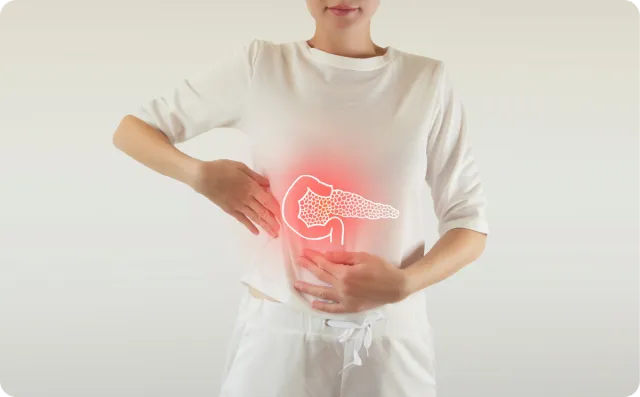
Jump to
Book a visit
$25 typical copay
$150 without insurance
Get fast relief for vomiting with a virtual GI consultation.
A virtual GI consultation allows you to discuss vomiting symptoms, including unusual colors and blood, with an expert who can provide insights and treatment options.
Key takeaways:
- Yellow vomit can mean bile is present in your stomach. Bile is a digestive fluid that can be in vomit when your stomach is empty or as a result of other digestive problems.
- While yellow vomit can occur from problems like acid reflux or minor digestive issues, it may also indicate a more serious issue, such as bile reflux or an intestinal blockage.
- If you experience frequent episodes of yellow vomit, especially in the presence of other symptoms, it's important to get medical attention as soon as possible.
If you are experiencing yellow vomit, it’s natural to be concerned, especially if you’re not sure why this is happening. Yellow vomit often contains bile, a yellow-green fluid produced by your liver. Yellow vomit can occur when your stomach is empty, but it can also mean that you may have other digestive problems like acid reflux or gastrointestinal issues.
Understanding when yellow vomit is normal and when it might be a sign of a more serious problem can help you decide if you should seek medical treatment. Let’s explore the possible causes of yellow vomit, when you should be concerned, and some of the available treatment options.
What is yellow vomit or bile?
Yellow vomit usually contains bile, a yellow-green fluid produced by your liver and stored in your gallbladder.
Bile is part of the normal process of digestion. It’s released into the upper part of your small intestine (the duodenum) to help you break down fats. Vomiting bile can happen when your stomach is empty or when there are other digestive problems present.
When throwing up yellow vomit or bile may be serious
Yellow vomit may be harmless, but there are some situations where it may be a sign of a more serious problem.
One of these problems is bile reflux, which is when bile backs up into your stomach. Another serious problem that can cause vomiting of yellow bile is a blockage in your intestines. In the case of an intestinal blockage, the vomiting usually won’t stop.
Other symptoms are almost always present, such as severe stomach pain, a feeling of fullness in your abdomen, and the inability to move your bowels or pass gas. If you are experiencing these symptoms, you should see a medical provider immediately.
Common causes of yellow vomit or bile
Several conditions can cause yellow vomit or bile. These can vary from relatively minor digestive problems to more serious issues.
Acid reflux
Acid reflux occurs when stomach acid flows back into your esophagus. This acid is quite irritating to your stomach lining and can be accompanied by bile refluxing back into your stomach from your small intestine.
When your stomach is empty and you vomit yellow fluid, you are bringing up bile, as there is nothing else in your stomach to expel. Other symptoms of acid reflux can include a burning sensation in your chest (heartburn) as well as a sour taste in your mouth.
Biliary reflux
Biliary reflux happens when bile washes back into your stomach and sometimes into your esophagus, irritating the lining.
Unlike acid reflux, biliary reflux involves bile fluid instead of stomach acid. Biliary reflux can lead to persistent yellow vomiting, stomach pain, nausea, heartburn, and a sour taste in your mouth.
Gastroenteritis
Gastroenteritis, often known as the stomach flu, can cause vomiting. Symptoms can also include vomiting of yellow bile when your stomach is empty.
Stomach flu is usually caused by a viral infection or food poisoning with food contaminated by bacteria. Besides vomiting, gastroenteritis also usually causes diarrhea and intestinal cramps. With rest and plenty of fluids, gastroenteritis will usually calm down and then completely resolve within a few days. If your symptoms continue or become more severe, you should see a healthcare provider.
Intestinal blockage
A blockage in your intestines, also known as a bowel obstruction, is a serious condition as it prevents food and fluids from passing through your intestines. The most common reasons for an obstruction in your small intestine are a hernia or scarring from prior surgery.
This leads to yellow vomiting, as well as other symptoms such as severe stomach pain, bloating, and the inability to move your bowels. An intestinal obstruction requires immediate medical attention, as without treatment, it can become life-threatening.
Common causes of yellow vomit or bile based on appearance or another symptom
The appearance of yellow vomit can provide you with some clues about its possible cause.
Yellow, foamy bile or vomit
If the vomit appears foamy and yellow, this can mean you have an excess of stomach acid or bile mixing with your stomach contents. This can happen during episodes of acid reflux or after repeated vomiting when your stomach is empty.
Yellow, liquid bile, or vomit
When the vomit is mostly liquid and yellow, this often means your stomach is empty, and bile is being thrown up.
This can happen with morning nausea (as in the morning sickness of pregnancy) or when you vomit after you have not eaten for a while.
Bright yellow bile or vomit
When bile has been recently produced, it’s more likely to color vomit a bright yellow. This is often seen in bile reflux or when you have eaten particular foods that tend to stimulate the production of bile, such as fats, bitter foods, or some spices.
Vomiting yellow while pregnant
If you are pregnant, you may experience yellow vomit due to morning sickness, especially if you are in the early stages of your pregnancy.
Hormonal changes and an empty stomach often cause morning sickness, which can actually happen at any time of day. While morning sickness is common and usually not dangerous, if you have persistent vomiting, you should discuss this with a healthcare provider.
Vomiting yellow after drinking alcohol
Alcohol is a well-known stomach irritant. If you drink alcohol on an empty stomach, bile can be present and lead to yellow vomit.
Read our full guide on vomit types and colors for more.
Diagnosing the causes of yellow vomit
Your healthcare provider will use a combination of your medical history, a review of your symptoms, and diagnostic tests to diagnose the cause of your yellow vomit. They may use some or all of the following methods.
- Physical examination: A physical exam allows your healthcare practitioner to check for signs of dehydration, abdominal tenderness, or other signs that may lead to a diagnosis.
- Blood tests: These can help to identify infections or problems with your liver function.
- Imaging tests: Ultrasound or CT scans can reveal blockages in your intestines or other abnormalities in your digestive system.
- Endoscopy: A tiny camera is guided down your throat and esophagus, then into your stomach and the upper part of your small intestine. The physician can examine these areas for signs of irritation, inflammation, or blockages.
Common treatment options for yellow vomit
There are several common treatment options for yellow vomit, and their use will vary depending on its cause.
Dietary changes
Adjustments in your diet can help to reduce the symptoms of acid and bile reflux. These changes may involve having you avoid acidic or spicy foods, eating smaller and more frequent meals, and avoiding lying down directly after eating.
Medications
Your healthcare provider may advise over-the-counter medications. They may also prescribe medications that reduce stomach acid, such as a proton pump inhibitor (PPI) to control bile flow. Anti-nausea medications can also help reduce nausea and vomiting.
Hydration
Drinking enough fluid is important, especially if you are vomiting frequently. Oral rehydration solutions such as some sports drinks or Pedialyte™ can help restore essential minerals such as sodium and potassium (electrolytes) that are lost when you vomit.
Nasogastric tube
If a bowel obstruction is present, a nasogastric (NG tube) is usually inserted through your nose and into the stomach. Fluids are drained from the stomach through the tube.
This helps to relieve pressure and abdominal swelling as well as vomiting. If there is a complete obstruction and conservative treatments such as the NG tube and bowel rest don’t work, surgery may be necessary to remove the blockage and clean up any dead or damaged tissue.
Questions to ask your doctor about yellow vomit or bile
When consulting with a healthcare provider about yellow vomit, it may be helpful to ask them these questions.
- What might be causing my yellow vomit?
- Are there specific tests needed to identify the source of the problem?
- What treatment options are most suitable for my condition?
- Do you have any suggestions as to how I can adjust my diet or lifestyle to help manage symptoms?
Frequently asked questions: yellow vomit or bile
Below are answers to some frequently asked questions that you may find helpful.
What can you eat or drink after throwing up yellow vomit or bile?
After vomiting, it’s best to start with clear fluids like small sips of water, flat soda, or oral rehydration solutions. You can then gradually introduce bland solid foods like saltine crackers, flavored gelatin, bananas, or soft, well-cooked rice as your stomach tolerates them. Gradually advance your diet as symptoms improve.
Read our full guide on what to eat after vomiting for more.
What if you’re experiencing yellow vomit and diarrhea at the same time?
If you are experiencing yellow vomit and diarrhea at the same time, you could have stomach flu (gastroenteritis) or another digestive problem. Because both vomiting and diarrhea cause a loss of bodily fluids, it’s especially important to stay hydrated. If the vomiting and diarrhea do not improve, you need to consult a healthcare provider.
Final thoughts
Yellow vomit is often related to digestive issues, such as acid reflux or vomiting on an empty stomach. Yellow vomit is often harmless, but it’s important to know when you need to get medical attention. If you continue to experience yellow vomit or if you have other symptoms such as stomach pain, fever, or the inability to pass gas or move your bowels, see a healthcare provider to get treatment.
General Medicine follows a strict editorial process, including using real experts to write our articles, vetted primary sources, fact-checking, a secondary medical review, and updates as necessary. This article was medically reviewed and fact checked by Dr. Lane Thaut, DO.
Sources
American College of Gastroenterology. “GERD: Gastroesophageal Reflux Disease.” American College of Gastroenterology, 2022, https://webfiles.gi.org/docs/patients/GERD-infographic-final_2022.pdf. Accessed 9 Oct. 2024.
American College of Obstetricians and Gynecologists. “Morning Sickness: Nausea and Vomiting of Pregnancy.” American College of Obstetricians and Gynecologists, https://www.acog.org/womens-health/faqs/morning-sickness-nausea-and-vomiting-of-pregnancy. Accessed 4 Oct. 2024.
Centers for Disease Control and Prevention. “Signs and Symptoms.” Centers for Disease Control and Prevention, U.S. Department of Health and Human Services, https://www.cdc.gov/food-safety/signs-symptoms/index.html. Accessed 9 Oct. 2024.
Centers for Disease Control and Prevention. “About Norovirus.” Centers for Disease Control and Prevention, U.S. Department of Health and Human Services, https://www.cdc.gov/norovirus/about/index.html. Accessed 9 Oct. 2024.
“Intestinal Obstruction: Evaluation and Management.” American Family Physician, vol. 98, no. 6, 2018, pp. 362-370, https://www.aafp.org/pubs/afp/issues/2018/0915/p362.html. Accessed 9 Oct. 2024.
McCabe, Marshall E., et al. “New Causes for the Old Problem of Bile Reflux Gastritis.” Clinical Gastroenterology and Hepatology, vol. 16, no. 9, 2018, pp. 1389-1392. https://www.cghjournal.org/article/S1542-3565(18)30222-2/pdf Accessed 9 Oct. 2024.
Our editorial standards
At General Medicine, we cut through the clutter to make health care clearer, faster, and easier to navigate. Every article is grounded in evidence-based research and peer-reviewed journals, reviewed by medical professionals, and written in accessible language that helps you make health decisions with confidence. We’re committed to ensuring the quality and trustworthiness of our content and editorial process by providing information that is up-to-date, accurate, and actually useful. For more details on our editorial process, see here.



